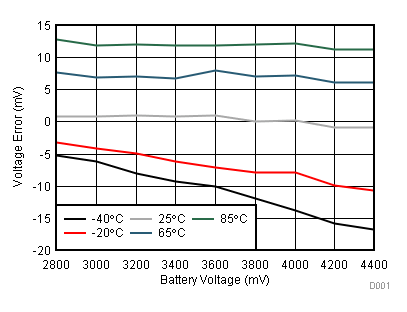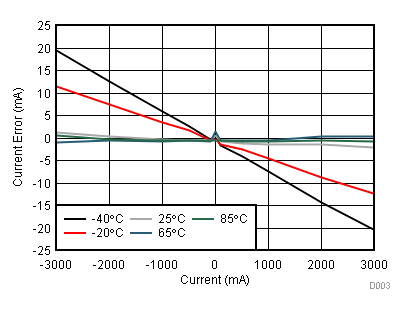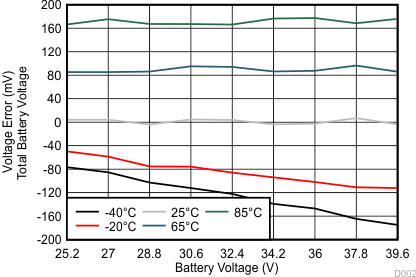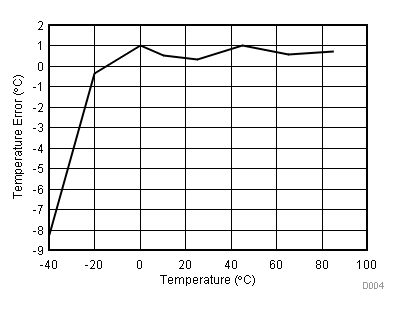SLUSCI1B August 2016 – November 2016
PRODUCTION DATA.
- 1 Features
- 2 Applications
- 3 Description
- 4 Revision History
- 5 Pin Configuration and Functions
-
6 Specifications
- 6.1 Absolute Maximum Ratings
- 6.2 ESD Ratings
- 6.3 Recommended Operating Conditions
- 6.4 Thermal Information
- 6.5 Electrical Characteristics: Supply Current
- 6.6 Electrical Characteristics: Digital Input and Output DC Characteristics
- 6.7 Electrical Characteristics: Power-On Reset
- 6.8 Electrical Characteristics: LDO Regulator
- 6.9 Electrical Characteristics: Internal Temperature Sensor
- 6.10 Electrical Characteristics: Low-Frequency Clock Oscillator
- 6.11 Electrical Characteristics: High-Frequency Clock Oscillator
- 6.12 Electrical Characteristics: Integrating ADC (Coulomb Counter)
- 6.13 Electrical Characteristics: ADC (Temperature and Voltage Measurements)
- 6.14 Electrical Characteristics: Data Flash Memory
- 6.15 Timing Requirements: I2C-Compatible Interface Timing Characteristics
- 6.16 Typical Characteristics
- 7 Detailed Description
- 8 Application and Implementation
- 9 Power Supply Recommendations
- 10Layout
- 11Device and Documentation Support
- 12Mechanical, Packaging, and Orderable Information
Package Options
Mechanical Data (Package|Pins)
- PW|14
Thermal pad, mechanical data (Package|Pins)
- PW|14
Orderable Information
6 Specifications
6.1 Absolute Maximum Ratings
Over operating free-air temperature range (unless otherwise noted)(1)| MIN | MAX | UNIT | ||
|---|---|---|---|---|
| VREGIN | Regulator input range | –0.3 | 5.5 | V |
| VCE | CE input pin | –0.3 | VREGIN + 0.3 | V |
| VREG25 | Supply voltage range | –0.3 | 2.75 | V |
| VIOD | Open-drain I/O pins (SDA, SCL, ALERT2) | –0.3 | 5.5 | V |
| VBAT | BAT input pin | –0.3 | 5.5 | V |
| VI | Input voltage range to all other pins (SRP, SRN, TS, ALERT1, VEN/GPIO, LEN) | –0.3 | VREG25 + 0.3 | V |
| TA | Operating free-air temperature range | –40 | 85 | °C |
| TJ | Operating junction temperature range | –40 | 100 | °C |
| TF | Functional temperature range | –40 | 100 | °C |
| TSTG | Storage temperature range | –65 | 150 | °C |
| Lead temperature (soldering, 10 s) | –40 | 100 | °C | |
(1) Stresses beyond those listed under Absolute Maximum Ratings may cause permanent damage to the device. These are stress ratings only, which do not imply functional operation of the device at these or any other conditions beyond those indicated under Recommended Operating Conditions. Exposure to absolute-maximum-rated conditions for extended periods may affect device reliability.
6.2 ESD Ratings
| VALUE | UNIT | |||
|---|---|---|---|---|
| V(ESD) | Electrostatic discharge | Human-body model (HBM), per ANSI/ESDA/JEDEC JS-001, BAT pin(1) | ±1500 | V |
| Human-body model (HBM), per ANSI/ESDA/JEDEC JS-001, all other pins(1) | ±2000 | |||
| Charged-device model (CDM), per JEDEC specification JESD22-C101(2) | ±500 | |||
(1) JEDEC document JEP155 states that 500-V HBM allows safe manufacturing with a standard ESD control process.
(2) JEDEC document JEP157 states that 250-V CDM allows safe manufacturing with a standard ESD control process.
6.3 Recommended Operating Conditions
TA= –40°C to 85°C, VREGIN = VBAT = 3.6 V (unless otherwise noted)6.4 Thermal Information
| THERMAL METRIC(1) | bq34110 | UNIT | |
|---|---|---|---|
| TSSOP (PW) | |||
| 14 PINS | |||
| RθJA | Junction-to-ambient thermal resistance | 103.8 | °C/W |
| RθJC(top) | Junction-to-case (top) thermal resistance | 31.9 | °C/W |
| RθJB | Junction-to-board thermal resistance | 46.6 | °C/W |
| ψJT | Junction-to-top characterization parameter | 2.0 | °C/W |
| ψJB | Junction-to-board characterization parameter | 45.9 | °C/W |
| RθJC(bot) | Junction-to-case (bottom) thermal resistance | N/A | °C/W |
(1) For more information about traditional and new thermal metrics, see the Semiconductor and IC Package Thermal Metrics application report, SPRA953.
6.5 Electrical Characteristics: Supply Current
TA= –40°C to 85°C, VREGIN = VBAT = 3.6 V (unless otherwise noted)| PARAMETER | TEST CONDITIONS | MIN | TYP | MAX | UNIT | |
|---|---|---|---|---|---|---|
| ICC_NORMAL | Normal operating current | Device in NORMAL mode, ILOAD > Sleep Current | 133 | µA | ||
| ISNOOZE(1) | Sleep+ operation mode current | Device in SNOOZE mode, ILOAD < Sleep Current | 53 | µA | ||
| ISLEEP(1) | Low-power SLEEP mode current | Device in SLEEP mode, ILOAD < Sleep Current | 22 | µA | ||
| ISHUTDOWN | SHUTDOWN mode current | Fuel gauge in SHUTDOWN mode, CE pin < VIL(CE) max | 0.01 | µA | ||
(1) Specified by design. Not production tested.
6.6 Electrical Characteristics: Digital Input and Output DC Characteristics
TA= –40°C to 85°C, VREGIN = VBAT = 3.6 V (unless otherwise noted)6.7 Electrical Characteristics: Power-On Reset
TA = –40°C to 85°C; typical values at TA = 25°C and VREGIN = 3.6 V (unless otherwise noted)| PARAMETER | TEST CONDITIONS | MIN | TYP | MAX | UNIT | |
|---|---|---|---|---|---|---|
| VIT+ | Positive-going battery voltage input at REGIN | 2.20 | V | |||
| VHYS | Power-on reset hysteresis | 115 | mV | |||
6.8 Electrical Characteristics: LDO Regulator
TA = 25°C, CREG25 = 1.0 μF, VREGIN = 3.6 V (unless otherwise noted)(1)| PARAMETER | TEST CONDITIONS | MIN | TYP | MAX | UNIT | |
|---|---|---|---|---|---|---|
| VREG25 | Regulator output voltage | 2.7 V ≤ VREGIN ≤ 4.5 V, IOUT ≤ 16 mA TA = –40°C to 85°C |
2.3 | 2.5 | 2.7 | V |
| 2.45 V ≤ VREGIN < 2.7 V, IOUT ≤ 3 mA TA = –40°C to 85°C |
2.3 | |||||
| ISHORT(2) | Short circuit current limit | VREG25 = 0 V TA = –40°C to 85°C |
250 | mA | ||
(1) LDO output current, IOUT, is the total load current. Use the LDO regulator to power the internal fuel gauge only.
(2) Specified by design. Not production tested.
6.9 Electrical Characteristics: Internal Temperature Sensor
TA = –40°C to 85°C, 2.4 V < VREG25 < 2.6 V; typical values at TA = 25°C and VREG25 = 2.5 V (unless otherwise noted)| PARAMETER | TEST CONDITIONS | MIN | TYP | MAX | UNIT | |
|---|---|---|---|---|---|---|
| GTEMP | Internal temperature sensor voltage gain | –2 | mV/°C | |||
6.10 Electrical Characteristics: Low-Frequency Clock Oscillator
TA = –40°C to 85°C, 2.4 V < VREG25 < 2.6 V; typical values at TA = 25°C and VREG25 = 2.5 V (unless otherwise noted)| PARAMETER | TEST CONDITIONS | MIN | TYP | MAX | UNIT | |
|---|---|---|---|---|---|---|
| f(LOSC) | Operating frequency | 32.768 | kHz | |||
| f(EIO) | Frequency error(1)(2) | TA = 0°C to 60°C | –1.5% | 0.25% | 1.5% | |
| TA = –20°C to 70°C | –2.5% | 0.25% | 2.5% | |||
| TA = –40°C to 85°C | –4% | 0.25% | 4% | |||
| t(SXO) | Start-up time(3) | 500 | µs | |||
(1) The frequency drift is included and measured from the trimmed frequency at VREG25 = 2.5 V, TA = 25°C.
(2) The frequency error is measured from 32.768 kHz.
(3) The start-up time is defined as the time it takes for the oscillator output frequency to be ±3%.
6.11 Electrical Characteristics: High-Frequency Clock Oscillator
TA = –40°C to 85°C, 2.4 V < VREG25 < 2.6 V; typical values at TA = 25°C and VREG25 = 2.5 V (unless otherwise noted)| PARAMETER | TEST CONDITIONS | MIN | TYP | MAX | UNIT | |
|---|---|---|---|---|---|---|
| f(LOSC) | Operating frequency | 8.389 | MHz | |||
| f(EIO) | Frequency error(1)(2) | TA = 0°C to 60°C | –2% | 0.38% | 2% | |
| TA = –20°C to 70°C | –3% | 0.38% | 3% | |||
| TA = –40°C to 85°C | –4.5% | 0.38% | 4.5% | |||
| t(SXO) | Start-up time(3) | 5 | ms | |||
(1) The frequency drift is included and measured from the trimmed frequency at VREG25 = 2.5 V, TA = 25°C.
(2) The frequency error is measured from 8.389 MHz.
(3) The start-up time is defined as the time it takes for the oscillator output frequency to be ±3%.
6.12 Electrical Characteristics: Integrating ADC (Coulomb Counter)
TA = –40°C to 85°C, 2.4 V < VREG25 < 2.6 V; typical values at TA = 25°C and VREG25 = 2.5 V (unless otherwise noted)| PARAMETER | TEST CONDITIONS | MIN | TYP | MAX | UNIT | |
|---|---|---|---|---|---|---|
| V(SR) | Differential input voltage range | V(SR) = V(SRP) – V(SRN) | –0.125 | 0.125 | V | |
| V(SRP), V(SRN) | Input voltage range, V(SRP) and V(SRN) | –0.125 | 0.125 | V | ||
| tSR_CONV | Conversion time | Single conversion | 1 | s | ||
| Resolution | 14 | 15 | bits | |||
| VOS(SR) | Input offset | 10 | µV | |||
| INL | Integral nonlinearity error | ±0.007% | FSR(1) | |||
| ZIN(SR) | Effective input resistance(2) | 2.5 | MΩ | |||
| ILKG(SR) | Input leakage current(2) | 0.3 | µA | |||
(1) Full-scale reference
(2) Specified by design. Not tested in production.
6.13 Electrical Characteristics: ADC (Temperature and Voltage Measurements)
TA = –40°C to 85°C, 2.4 V < VREG25 < 2.6 V; typical values at TA = 25°C and VREG25 = 2.5 V (unless otherwise noted)| PARAMETER | TEST CONDITIONS | MIN | TYP | MAX | UNIT | |
|---|---|---|---|---|---|---|
| VIN((ADC) | ADC input voltage range for BAT measurement | Internal voltage divider inactive, internal VREF | 0.05 | 1 | V | |
| Internal voltage divider activated, internal VREF | 0.05 | 4.5 | V | |||
| ADC input voltage for TS pin measurement | 0 | VREG25 | V | |||
| tADC_CONV(1) | Conversion time | Single conversion | 125 | ms | ||
| Resolution | 14 | 15 | bits | |||
| VOS(ADC) | Input offset | 1 | mV | |||
| ZADC_TS | Effective input resistance (TS with internal pull-down activated)(1) | 5 | kΩ | |||
| ZADC_BAT | Effective input resistance (BAT)(1) | When not measuring cell voltage (internal voltage divider inactive) | 8 | MΩ | ||
| During measurement of cell voltage using internal divider (internal voltage divider active) | 100 | kΩ | ||||
| ILKG(ADC) | Input leakage current(1) | 0.3 | µA | |||
(1) Specified by design. Not tested in production.
6.14 Electrical Characteristics: Data Flash Memory
TA = –40°C to 85°C, 2.4 V < VREG25 < 2.6 V; typical values at TA = 25°C and VREG25 = 2.5 V (unless otherwise noted)| PARAMETER | TEST CONDITIONS | MIN | TYP | MAX | UNIT | |
|---|---|---|---|---|---|---|
| tDR | Data retention(1) | 10 | Years | |||
| Flash –programming write cycles(1) | 20,000 | Cycles | ||||
| tWORDPROG | Word programming time(1) | 2 | ms | |||
| ICCPROG | Flash-write supply current(1) | 5 | 10 | mA | ||
(1) Specified by design. Not tested in production.
6.15 Timing Requirements: I2C-Compatible Interface Timing Characteristics
TA = –40°C to 85°C, 2.4 V < VREGIN = VBAT < 5 V; typical values at TA = 25°C and VREGIN = VBAT = 3.6 V (unless otherwise noted)| PARAMETER | TEST CONDITIONS | MIN | NOM | MAX | UNIT | |
|---|---|---|---|---|---|---|
| tR | SCL/SDA rise time | 300 | ns | |||
| tF | SCL/SDA fall time | 300 | ns | |||
| tW(H) | SCL pulse width (high) | 600 | ns | |||
| tW(L) | SCL pulse width (low) | 1.3 | µs | |||
| tSU(STA) | Setup for repeated start | 600 | ns | |||
| td(STA) | Start to first falling edge of SCL | 600 | ns | |||
| tSU(DAT) | Data setup time | 100 | ns | |||
| th(DAT) | Data hold time | 0 | ns | |||
| tSU(STOP) | Setup time for stop | 600 | ns | |||
| tBUF | Bus free time between stop and start | 66 | µs | |||
| fSCL | Clock frequency | 400 | kHz | |||
 Figure 1. I2C-Compatible Interface Timing Diagram
Figure 1. I2C-Compatible Interface Timing Diagram
6.16 Typical Characteristics
 Figure 2. V(Err) Across VIN (0 mA)
Figure 2. V(Err) Across VIN (0 mA)
 Figure 4. I(Err)
Figure 4. I(Err)
 Figure 3. V(Err) Across VIN (0 mA) for a 9-Series Configuration
Figure 3. V(Err) Across VIN (0 mA) for a 9-Series Configuration
 Figure 5. T(Err)
Figure 5. T(Err)